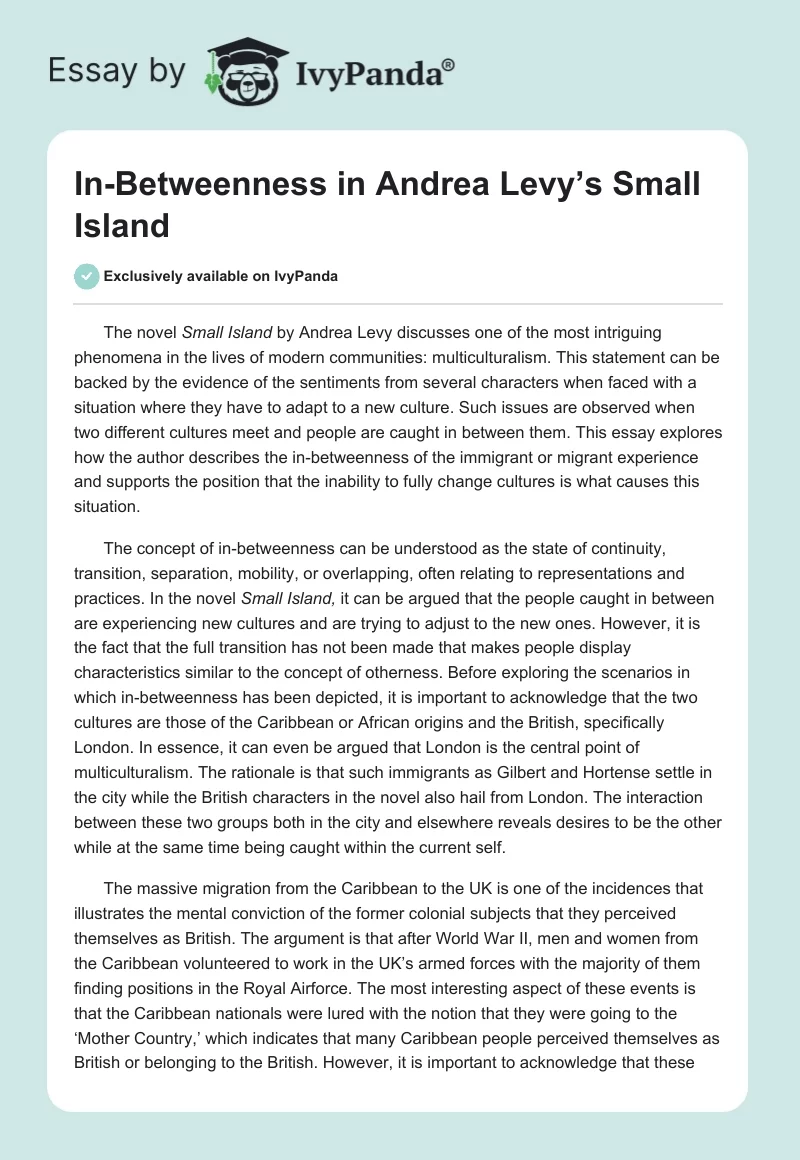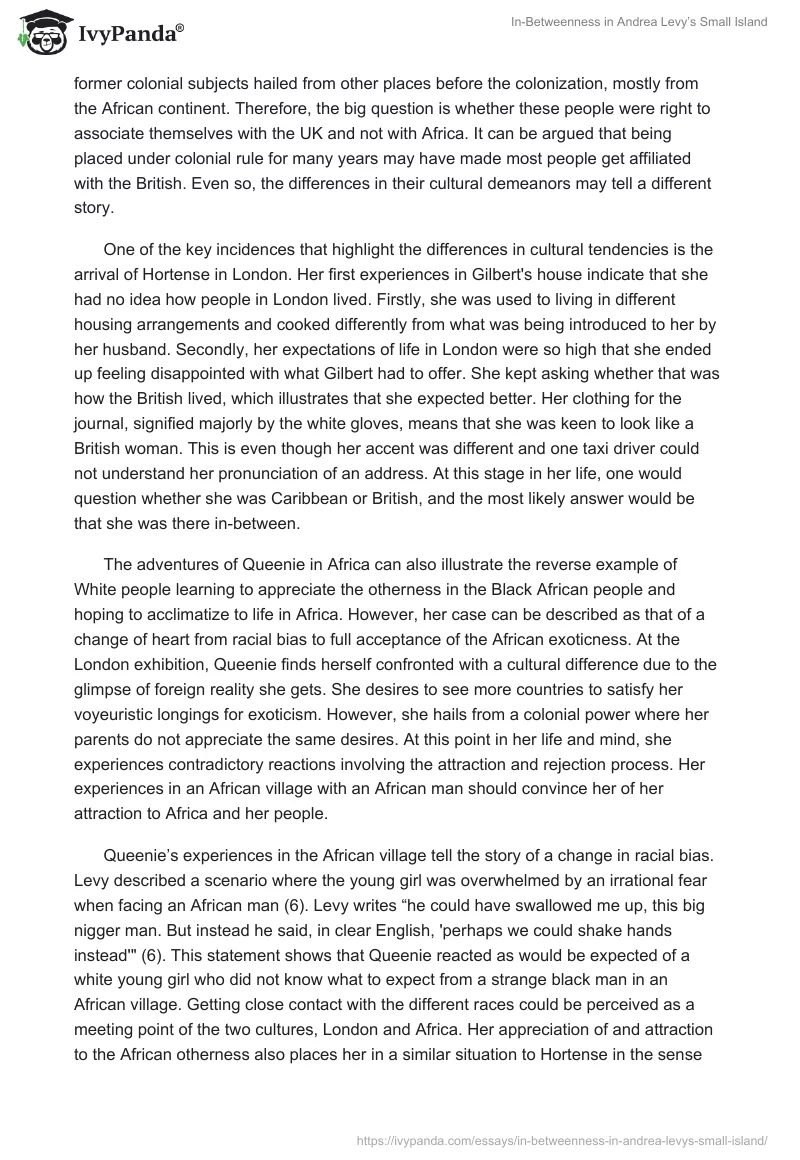The novel Small Island by Andrea Levy discusses one of the most intriguing phenomena in the lives of modern communities: multiculturalism. This statement can be backed by the evidence of the sentiments from several characters when faced with a situation where they have to adapt to a new culture. Such issues are observed when two different cultures meet and people are caught in between them. This essay explores how the author describes the in-betweenness of the immigrant or migrant experience and supports the position that the inability to fully change cultures is what causes this situation.
The concept of in-betweenness can be understood as the state of continuity, transition, separation, mobility, or overlapping, often relating to representations and practices. In the novel Small Island, it can be argued that the people caught in between are experiencing new cultures and are trying to adjust to the new ones. However, it is the fact that the full transition has not been made that makes people display characteristics similar to the concept of otherness. Before exploring the scenarios in which in-betweenness has been depicted, it is important to acknowledge that the two cultures are those of the Caribbean or African origins and the British, specifically London. In essence, it can even be argued that London is the central point of multiculturalism. The rationale is that such immigrants as Gilbert and Hortense settle in the city while the British characters in the novel also hail from London. The interaction between these two groups both in the city and elsewhere reveals desires to be the other while at the same time being caught within the current self.
The massive migration from the Caribbean to the UK is one of the incidences that illustrates the mental conviction of the former colonial subjects that they perceived themselves as British. The argument is that after World War II, men and women from the Caribbean volunteered to work in the UK’s armed forces with the majority of them finding positions in the Royal Airforce. The most interesting aspect of these events is that the Caribbean nationals were lured with the notion that they were going to the ‘Mother Country,’ which indicates that many Caribbean people perceived themselves as British or belonging to the British. However, it is important to acknowledge that these former colonial subjects hailed from other places before the colonization, mostly from the African continent. Therefore, the big question is whether these people were right to associate themselves with the UK and not with Africa. It can be argued that being placed under colonial rule for many years may have made most people get affiliated with the British. Even so, the differences in their cultural demeanors may tell a different story.
One of the key incidences that highlight the differences in cultural tendencies is the arrival of Hortense in London. Her first experiences in Gilbert’s house indicate that she had no idea how people in London lived. Firstly, she was used to living in different housing arrangements and cooked differently from what was being introduced to her by her husband. Secondly, her expectations of life in London were so high that she ended up feeling disappointed with what Gilbert had to offer. She kept asking whether that was how the British lived, which illustrates that she expected better. Her clothing for the journal, signified majorly by the white gloves, means that she was keen to look like a British woman. This is even though her accent was different and one taxi driver could not understand her pronunciation of an address. At this stage in her life, one would question whether she was Caribbean or British, and the most likely answer would be that she was there in-between.
The adventures of Queenie in Africa can also illustrate the reverse example of White people learning to appreciate the otherness in the Black African people and hoping to acclimatize to life in Africa. However, her case can be described as that of a change of heart from racial bias to full acceptance of the African exoticness. At the London exhibition, Queenie finds herself confronted with a cultural difference due to the glimpse of foreign reality she gets. She desires to see more countries to satisfy her voyeuristic longings for exoticism. However, she hails from a colonial power where her parents do not appreciate the same desires. At this point in her life and mind, she experiences contradictory reactions involving the attraction and rejection process. Her experiences in an African village with an African man should convince her of her attraction to Africa and her people.
Queenie’s experiences in the African village tell the story of a change in racial bias. Levy described a scenario where the young girl was overwhelmed by an irrational fear when facing an African man (6). Levy writes “he could have swallowed me up, this big nigger man. But instead he said, in clear English, ‘perhaps we could shake hands instead’” (6). This statement shows that Queenie reacted as would be expected of a white young girl who did not know what to expect from a strange black man in an African village. Getting close contact with the different races could be perceived as a meeting point of the two cultures, London and Africa. Her appreciation of and attraction to the African otherness also places her in a similar situation to Hortense in the sense that she was there in-between the two cultures. Even though there are no expressions of her desire to become African or follow their cultures, the connection between the two cultures and the people caught in between them is an illustration of in-betweenness.
Gilbert can represent the male Caribbean immigrants into Britain and their experiences of in-betweenness. He was one of the people who sailed on the MV Windrush and was bewildered by what he saw in the ‘Mother Country’ as all the male immigrants were. He had been taught to exalt Britain and even to think of himself as British (Levy 175). Upon his arrival, he realized that even the British had difficulties in life, most of which were witnessed by Hortense upon her arrival at Gilbert’s house. However, his in-betweenness is observed when the state refused to recognize the nationality of the black subjects and to fulfill its obligation to them. This can be seen as the catalyst in the formation of the Caribbean diaspora in Britain who often lived like a community on fringes. In the novel, it can be seen that the Caribbean immigrants can only afford to live in degraded housing, where they also often met to discuss their experiences. However, this point can be contested because some of the residents in the houses they lived in were also white.
Therefore, even though immigration comes from both sides of the racial spectrum, it can be argued that the people who often find themselves caught in between the cultures are the black immigrants. The argument is that they are the ones who need to adapt and possibly assimilate themselves to the ‘Mother Country’ because Britain was not going to change to accommodate them. As for the British in Africa, most feared being possessed by the dominant other whereas most black immigrants seemed eager to assimilate. The former colonial subjects would like to work and live like the British, which explains the massive immigration. Therefore, although a few of the Whites found themselves caught between two cultures, it is the Caribbean immigrants into Britain who most experienced the in-betweenness.
In conclusion, it has been argued that Andrea Levy described the in-betweenness of the immigrant or migrant experiences through multiculturalism or the crash of two cultures. The Caribbean immigrants into Britain were the most affected group because they needed to adapt and assimilate to the British culture to fit in. However, the fact that the promise made to them was not fulfilled resulted in the creation of a diaspora community who could hardly identify themselves as British. The whites may also have had similar experiences with the African cultures but they did not feel the same level of obligation to assimilate to the dominant other. The examples of Gilbert’s and Hortense’s expectations reveal that it was not entirely possible to switch from the Caribbean to British.
Work Cited
Levy, Andrea. Small Island. Headline Publishing Group, 2004.


